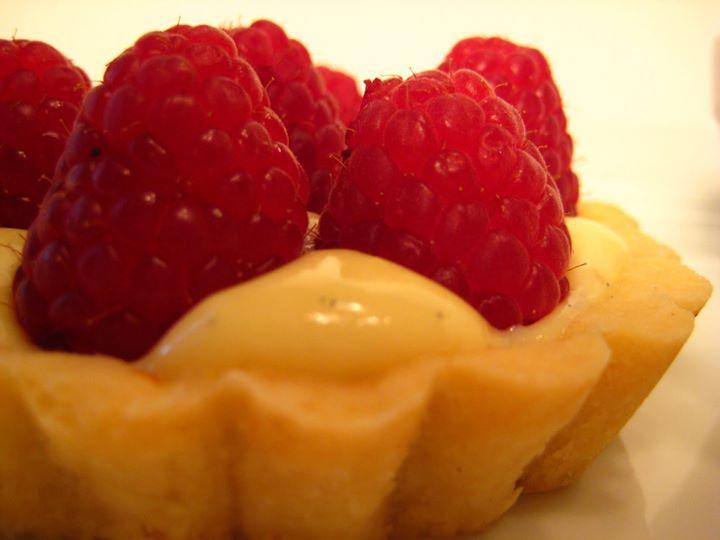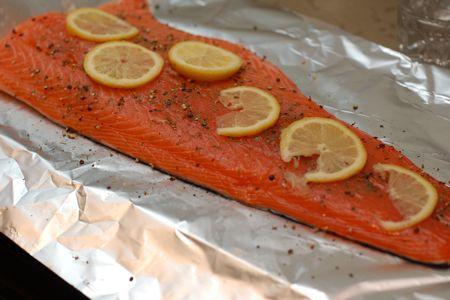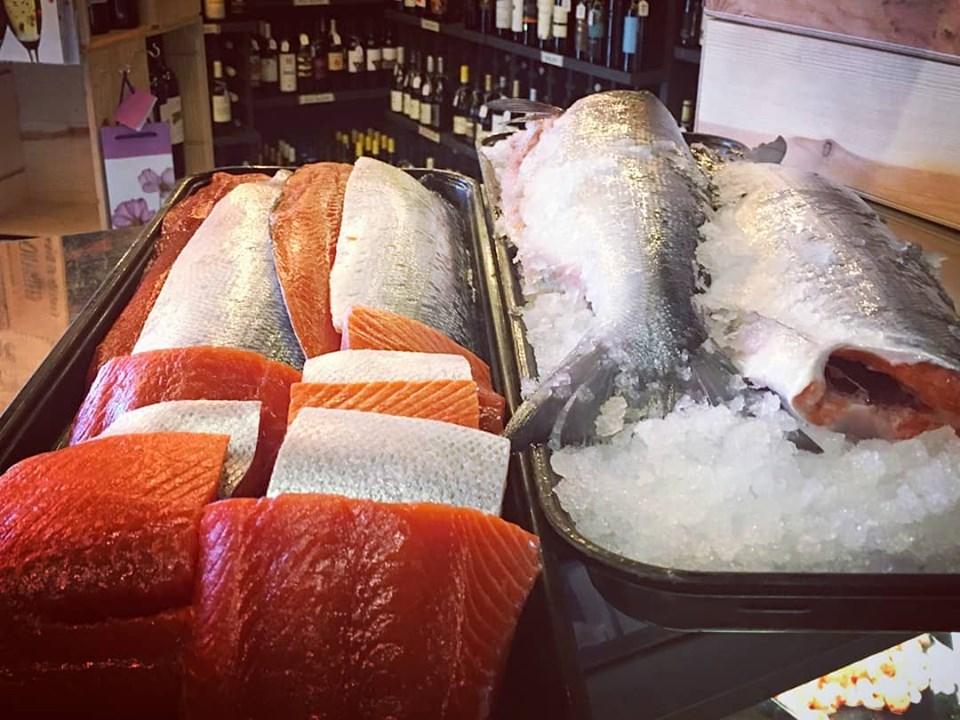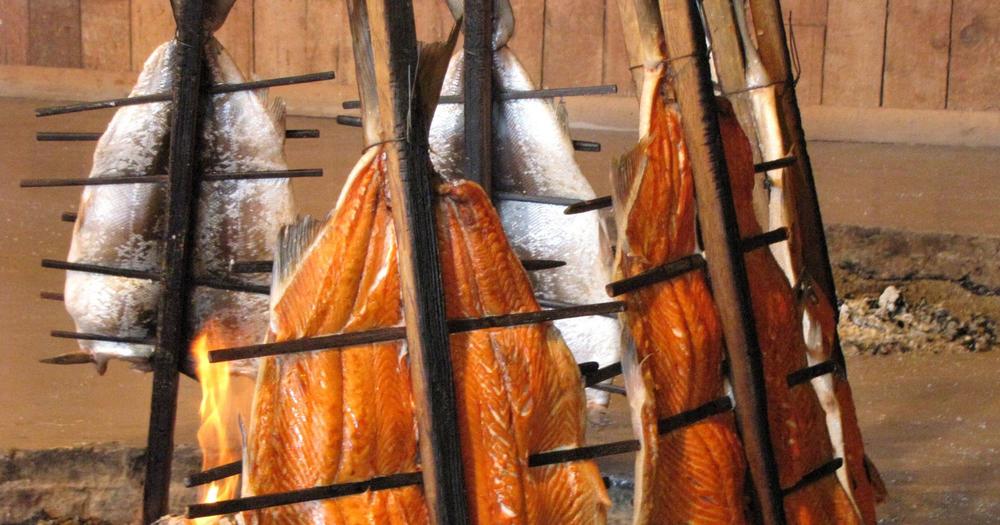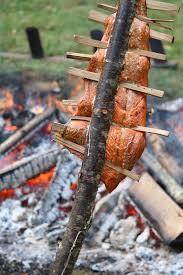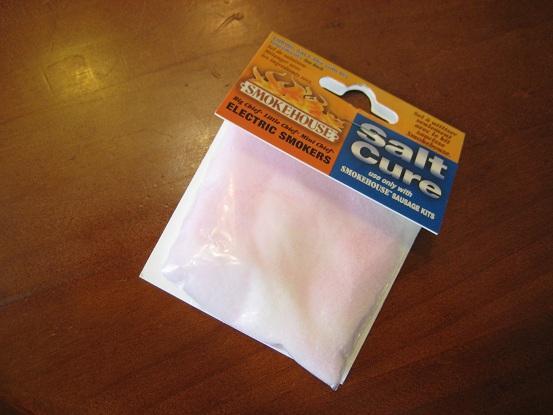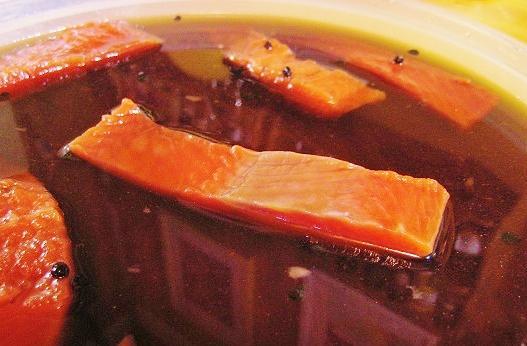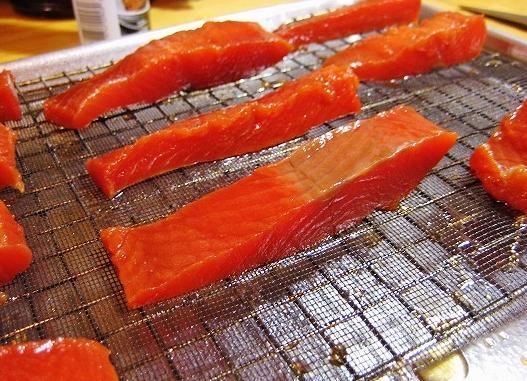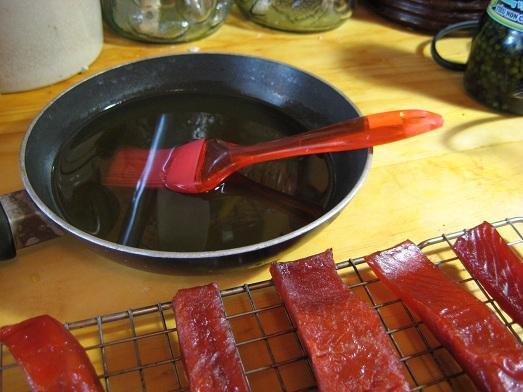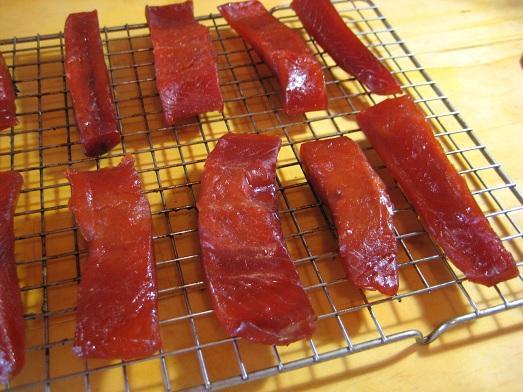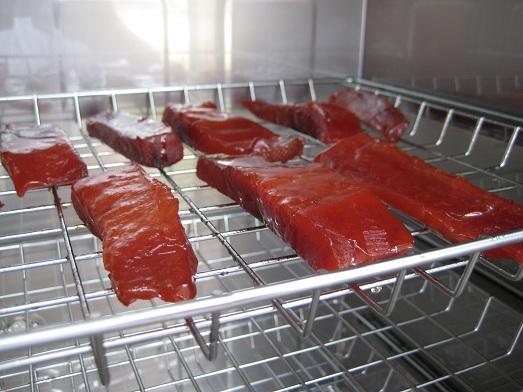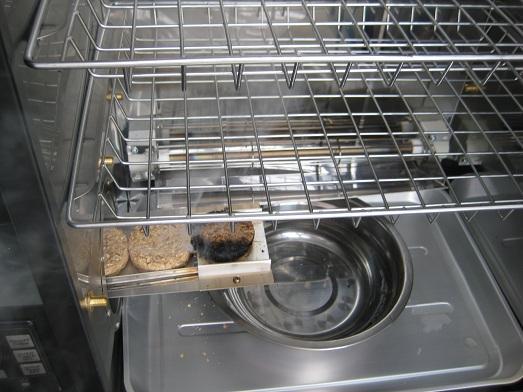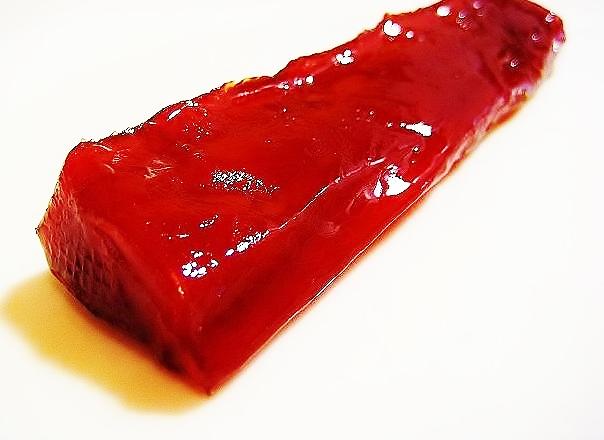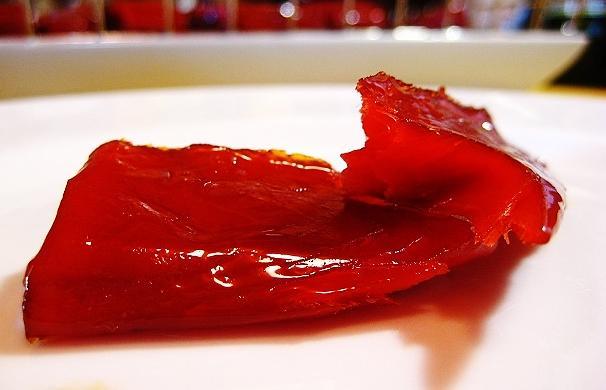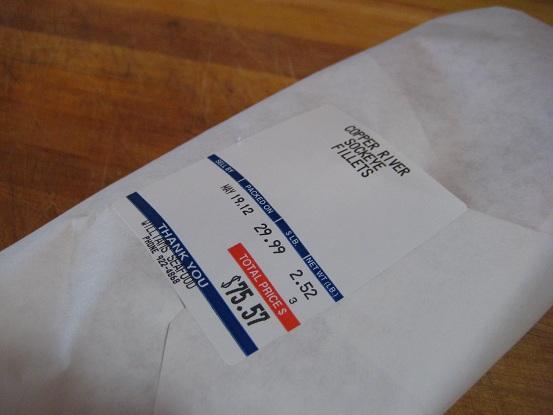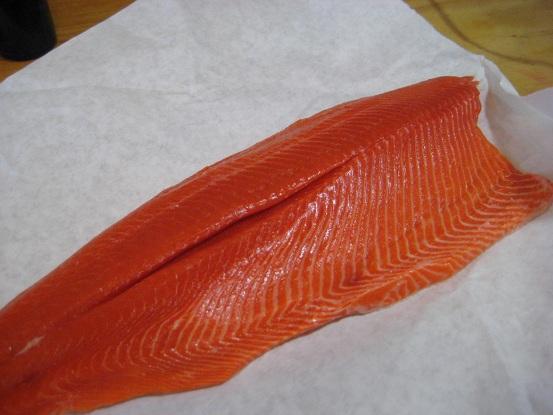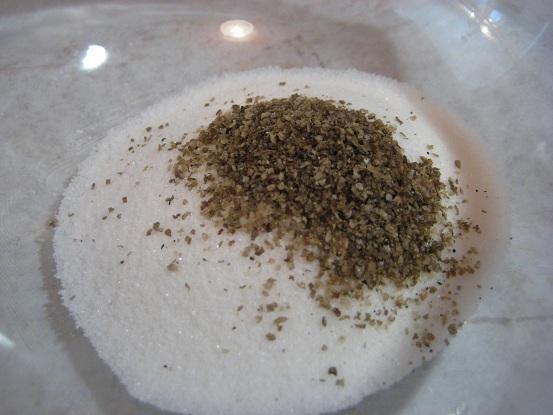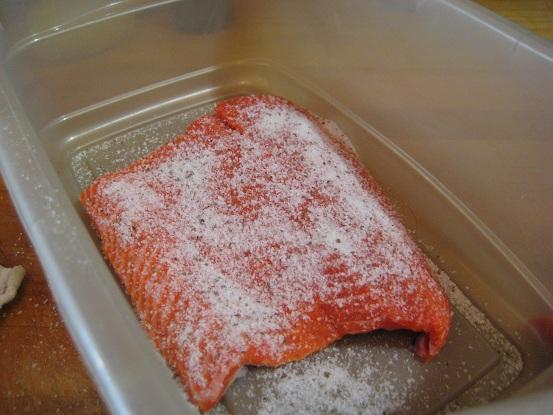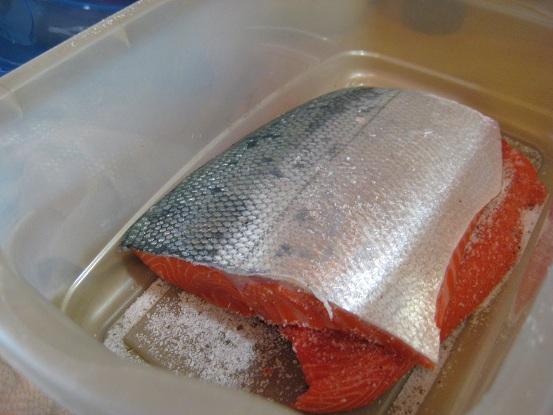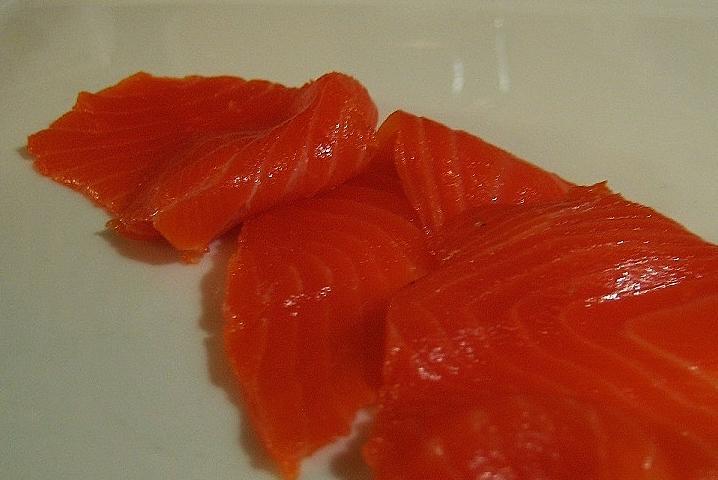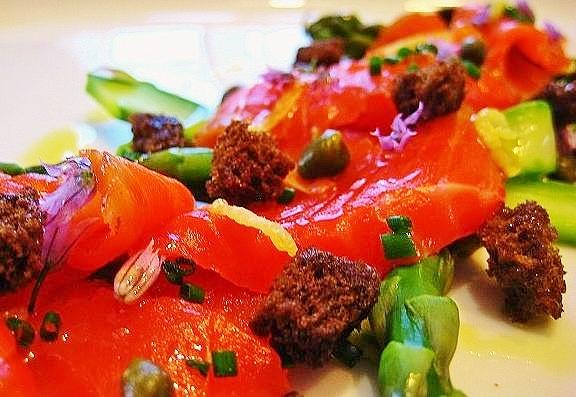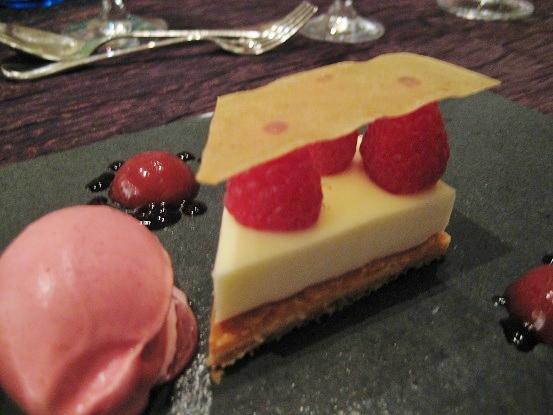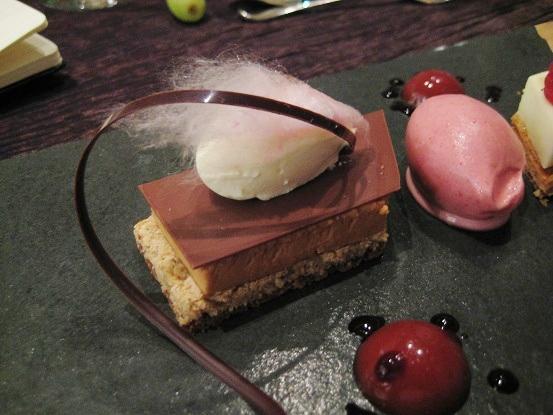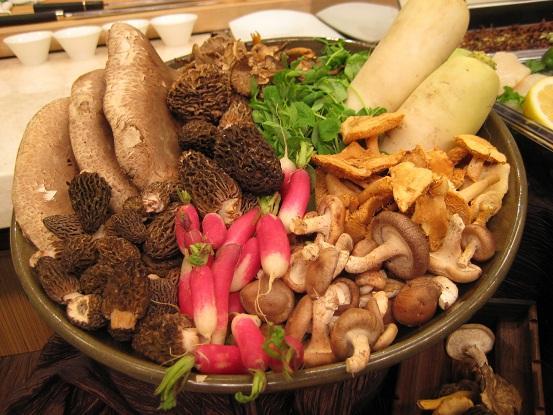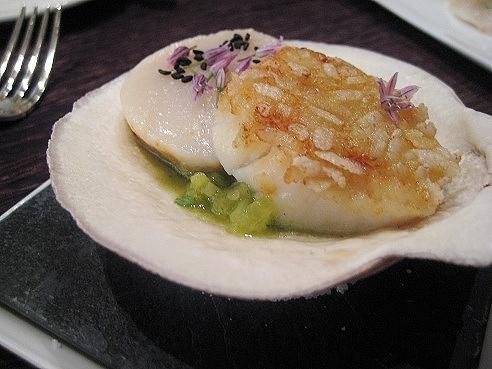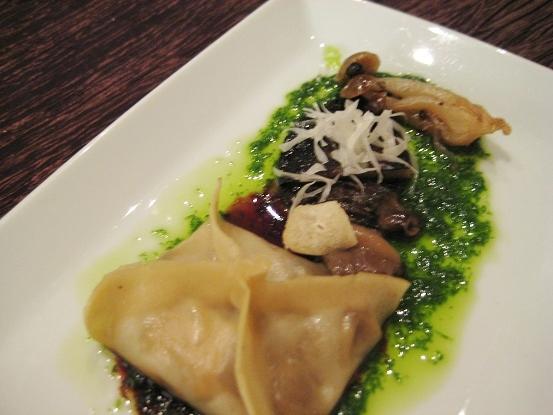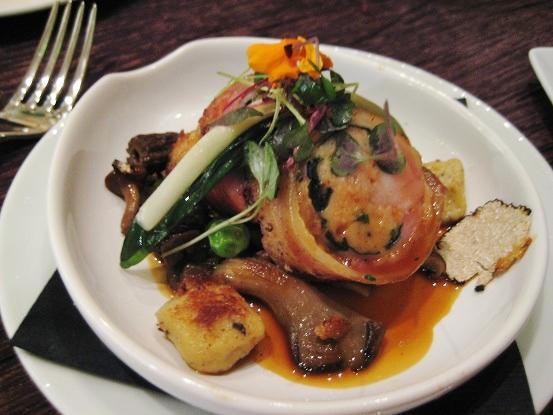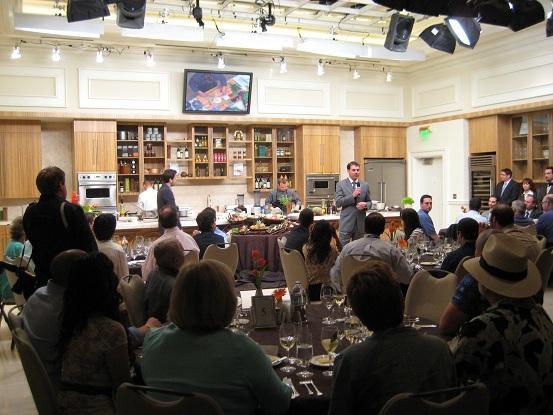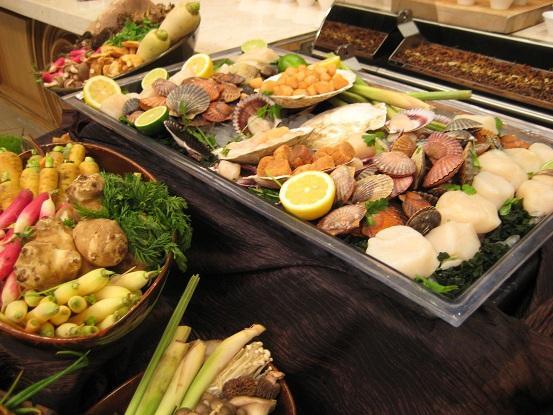-
Posts
5,035 -
Joined
-
Last visited
Content Type
Profiles
Forums
Store
Help Articles
Everything posted by David Ross
-
What are your thoughts on wrapping salmon in foil on the bbq? I grew up in Salem in the Willamette Valley or Oregon, about 90 minutes from the coast. Every summer we would have fresh salmon and Father would grill it on the bbq. We bought whole sides of salmon and he'd season it, add some lemon slices, (similar to the photo), then wrap the whole thing in foil. It was a pretty popular technique back in the 60's and 70's, but even back then I thought it seemed odd. The salmon was delicious and moist, but to me it's just basically steamed in foil. I happen to prefer salmon openly grilled so that the skin gets charred yet the meat stays moist. Some people use the foil as a support for the salmon so it doesn't stick to the grill but they don't wrap it tight, let the smoke permeate the salmon. I use a non-stick fish grate so the salmon is exposed to the fire and smoke. What do you do when grilling salmon?
-
Thanks for the tips. I tried the salad cold but preferred it when I tried it room temperature. I love wood ear mushrooms so I'll try those next time.
-
Looks delicious. I'm having something similar for dinner tonight. (and I also make it for breakfast).
-
Last week I was working on how to combine Korean flavors with salmon. I've been doing Chinese dishes for years and started dabbling in Japanese cooking a few years back, but have never done any Korean dishes at home until last year. One of the local Asian markets was bought last year by a Korean family and now it's my favorite of the three markets in town. They specialize in Korean ingredients and the lady and her husband who own the shop couldn't be more nice. When I was in the market looking for a specific Korean Doenjang soybean paste, she was curious I had the right one. She thought I wanted Japanese Miso, but when I explained the recipe she was quite pleased. She directed me to the correct package of Korean Japchae noodles for the salad I planned on making to go with the salmon. In this recipe I made a paste using Doenjang and slathered that over the top of the salmon. The salmon was grilled on alder planks on the outdoor grill. The Doenjang is stronger than Japanese miso and has a bit of heat, but I loved it. I'll use it again and test it against recipes for Japanese miso. Most of the planks sold for grilling are cedar, but I prefer the alder for a milder smoke flavor. The Japchae noodle salad wasn't something I've made before but I thought it was crisp and refreshing. The noodles don't have much flavor but I liked the texture and they went well with the vegetables in the dressing. I had some salmon leftover and put that into the salad the next day. Korean BBQ Salmon with Japchae Noodle Salad- Chilled Japchae Noodle Salad- 10 oz. Korean Japchae noodles-glass noodles made from potato starch 1 bunch fresh spinach ½ cup fresh bean sprouts ½ yellow onion, thinly sliced ½ red bell pepper, thinly sliced ½ cup julienned carrot 1 tbsp. olive oil 2 garlic cloves, mincd 2 tbsp. soy sauce 1/2 tsp. dried red chili flakes 1 tbsp. apple cider vinegar 1 tbsp. sugar 1 tsp. toasted sesame seeds Heat a pot of water to the boil, then add the Japchae noodles. Cook the noodles until tender, about 7 minutes. Drain the noodles and rinse with cold water. Drain the noodles again. Place the noodles in a large bowl. Heat another saucepot of water to a simmer and add the spinach. Cook the spinach until wilted, about one minute. Drain the spinach then roughly chop. Add the spinach, bean sprouts, onion, red bell pepper, carrot and olive oil to the bowl with the noodles and toss to combine. In a small bowl add the garlic, soy sauce, chili flakes, vinegar, sugar and sesame seeds and stir to combine. Pour the dressing over the noodles and vegetables and toss to combine. Place the salad in a container, cover and refrigerate to chill, at least one hour while you make the salmon. Spicy Korean BBQ Salmon- ½ cup Korean Doenjang soybean paste ½ cup Mayonnaise 2 tbsp. Korean Gochujang chili paste 1 tbsp. granulated sugar 1 tsp. dried red chile flakes 2 tsp. grated lemon zest 1 tbsp. fresh lemon juice 4, 6oz. salmon filets 1 tbsp. olive oil Salt and cracked black pepper 4 alderwood, (or cedar), grilling planks, soaked in water 1 hour 2 fresh lemons 1 tsp. black sesame seeds In a bowl add the soybean paste, mayyonnaise, chili paste, sugar, lemon zest and lemon juice and whisk to combine. Brush the bottom side of each salmon filet with olive oil. Sprinkle the top side of each salmon filet with salt and cracked black pepper. Using a spoon, spread a layer of the Spicy Korean BBQ sauce over the top of each salmon filet. Drain the alder planks from the water. Place each salmon filet on one of the planks and grill. Cut the lemons in half. Grill the lemons to create grill marks while the salmon is grilling on the alder planks. Serve the salmon directly on the planks sprinkled with black sesame seeds. Serve the grilled lemons with the salmon. Serve the chilled Japchae Noodle Salad on the side.
-
The annual rush here in the Pacific Northwest has been begun with the Copper River salmon now turning up in markets. My emotions vary between happiness and shaking my head in frustration. The Copper River is commanding prices nearing $60 per pound right now. The market of course is priced based on what peope will pay, but the years of marketing, PR and rising the Copper River up to a social media iconic status has pushed the cost pretty much beyond reach. If you dine at a restaurant serving Copper River salmon right now you will pay a premium, but you're only buying one plate. At some of the markets that sell Copper River salmon they require you buy a whole or side of salmon. I have to shop at a place that will sell me only a few filets. I don't need a whole salmon at that price but can handle a few filets. What I've done for a few years now is to wait a few weeks and let the Copper River price come down. Even better, wait until the salmon from other rivers in Alaska, (that don't subscribe to the Copper River juggernaught), is available. It's just a rich and has as much deep flavor as Copper River.
-
Grilling on wood planks has become very popular. Yet, grilling salmon on wood planks and stakes has been practiced for millennia. When we were kids growing up in The Dalles, Oregon, Mother and Father would take us every summer to a traditional Native American salmon roast. The salmon were fished from the Columbia River that borders the north side of The Dalles. I still remember the taste of that wild salmon-moist, tender with just a hint of alder smoke. Alder grows in the forests on the west side of the Cascade Mountain range that runs from British Columbia down through Washington, Oregon and into Northern California. Back then, (the 1960's), the salmon roast was a very traditional affair without some of the commercial-style trappings you'll find today. But the salmon is just as delicious today as it was in 1967.
-
I'm working on my next salmon dish. I'll be using a technique that Native Americans here in the Pacific Northwest have been using for generations-grilling salmon over alderwood. I adapt the technique to my outdoor grill and use small alderwood planks. I'm thinking of introducing some Asian flavors to the salmon.
-
Good point. When I've been in Hawaii I was always suspect of salmon on restauranthet menus. I think, "why would I order salmon that's been flown in from thousands of miles instead of ordering fresh, local Hawaiian fish."
-
While salmon is a staple in Japan, I haven't found many recipes where salmon is used in countries in Southeast Asia. Is it just a matter of the waters being too warm to support salmon or is it just not as popular as other fish?
-
This is a new salmon dish I made a few months back. It was sort of an adventure and part of our Avocado Cook-Off here https://forums.egullet.org/topic/158091-eg-cook-off-81-the-avocado-finding-new-popularity-in-the-kitchen/. I knew I wanted to do something different with avocado and I wanted to pair it with salmon. I had never heard of pickled avocado, it was just a thought that popped into my head. I started with an online recipe, then tinkered with it a bit to add some different spices so the dish would have Mexican flavors. Then using the pickled avocado I used it in a watermelon salsa to go with pan-roasted salmon. I don't remember now, but I'm pretty sure this was fresh, albeit farmed, Atlantic salmon. It looks better when you photograph it than it tastes. The farmed salmon we get isn't from the cold waters of Northern Europe. It doesn't have much flavor or color. I might have been better off using frozen wild salmon. Wild salmon would have the bold taste to go better with the flavors of the salsa. Pickled Avocado-Watermelon Salsa-makes 3 cups ½ cup white vinegar ½ cup water 1 tbsp. Kosher salt 1 tbsp. sugar 1 tsp. coriander seeds 1 tsp. mustard seeds 1 tsp. cumin seeds 6 fresh cilantro sprigs 2 cloves garlic, thinly sliced 1 tbsp. finely diced jalapeno 1 tsp. lime zest 2 unripe avocados 1 cup, seedless watermelon cut into small cubes ½ cup finely chopped onion 2 cloves garlic, minced 1 tbsp, minced jalapeno ½ cup finely chopped cilantro 2 tbsp. fresh lime juice 2 tbsp. olive oil Salt and pepper to taste Combine the vinegar, salt, sugar, coriander, mustard and cumin seeds and water in a small saucepan over high heat. Bring to a boil and stir to dissolve the salt and sugar. Remove the saucepan from the heat and pour the brine into a container. Add the cilantro, garlic, jalapeno and lime zest to the brine. Let the brine cool to room temperature. Cut the avocados in half then remove the pit. Peel off the skin and dice the avocado into small cubes. When the brine is cooled add the avocado cubes. Cover the container and refrigerate the avocado overnight. The pickled avocado will keep in the refrigerator for up to two weeks. Before serving, drain the pickled avocado from the brine. Place in a bowl and add the fresh watermelon and avocado cubes, the onion, garlic, cilantro, lime juice and olive oil and gently toss to combine. Season with salt and pepper to taste. The salsa should be served the same day you combine all the ingredients. Salmon- 4, 6-8 oz. salmon filets 2 tsp. mustard powder 2 tsp. chili powder Salt and fresh ground black pepper 2 tbsp. butter 3 tbsp. olive oil Heat the oven to 400. Rub each salmon filet with some of the mustard and chili powder and season with salt and pepper. Heat a skillet over medium heat and add the butter and 2 tbsp. olive oil. Add the salmon filets and brown on each side, about 2-3 minutes per side. Transfer the skillet to the oven and roast the salmon for another 4-5 minutes or until the salmon is firm to the touch and done. Pan-Roasted Salmon with Pickled Avocado-Watermelon Salsa-
-
For my tastes I always prefer sockeye over king salmon-grilling, smoking, curing, just about any type of preparation. I think it has more flavor and a higher oil content than king salmon and it's a stretch then for me to pay the price of king salmon.
-
"Smoked Salmon Candy" is a traditional dish we make in the Northwest. Similar to regular hot-smoked salmon, it involves some unique and different steps. The result is smoked salmon that is salty and sweet yet very moist. It has a deep, vibrant red color with a glossy, almost transparent finish. Legend says that Smoked Salmon Candy is the creation of Native Canadians who married the process of brining, drying and smoking salmon with pure maple syrup. I first had Smoked Salmon Candy as an appetizer at the Waterfront Hotel in Vancouver, Canada. I remember the menu description led me to believe it was basically a smoked salmon dish with traditional garnishes--then the plate arrived at the table and I realized that I was in for a new experience--small logs of deep-red, almost transluscent salmon with a rich, oily sheen nestled alone on the plate. The salmon had a firm, yet soft texture, somewhere between cold-smoked salmon and what we know as salmon jerky. But it was anything but the dry, chewy texture of a jerky. The sweet flavor of Canadian Maple Syrup was counter-balanced by a good measure of salt. It was a revelation for me. I had never tasted smoked salmon so unique and so delicious. That's when I first fell in love with Smoked Salmon Candy. I first made Smoked Salmon Candy during our Cook-Off #59: Cured, Brined, Smoked and Salted Fish. The first question I asked was about using sodium nitrite in the cure. I had never used it on fish, only meat. Apparently sodium nitrite is sometimes used in the brine for smoked fish to kill any bacteria during the unsafe temp window of 40-140 used during smoking. In the end I didn't use it, only pickling salt. The process of crafting Smoked Salmon Candy at home takes me a week--2 days of brining, 4 days of drying and 1 day of smoking. I start with a whole side of Wild Alaska Sockeye Salmon. Frozen works well, but we prefer fresh spring salmon to celebrate the season. I cut the salmon into 1" wide filet strips and then let them sit in the brine for 24 hours. The brine- 10 cups water 1/2 cup pickling salt 2 cups dark brown sugar 1 cup maple syrup 1 tbsp. black peppercorns I've tried this recipe with 8 cups water to 1 cup salt and it was far too salty for my tastes. Into the brine- The salmon comes out of the brine and is rinsed in clean, cold water. The next step, drying, was a shock to me at first. I've cured salmon before but always let it dry in the cool fridge. The traditional recipe I started with calls for drying at room temperature or outside. But the recipe works perfect and there hasn't been any danger drying the salmon in the back pantry. Most recipes call for drying the salmon for 1-2 days. I stretch it on this point and dry the salmon, uncovered, at air temperature, for 4 days. I check the salmon by touch each day to make sure it isn't getting to dry and still has some spring to the flesh and develops a sheen on the surface. The idea is to dry the meat and concentrate the flavors, yet not take it to the point where the flesh is fully dried-out. The salmon filets on a rack over a cookie sheet to dry- After 4 days of drying at room temperature, I brush the filets with a mixture of 3/4 cup clover honey and 1/4 cup water. The maple syrup and brown sugar in the brine sweeten the meat of the salmon, and the honey is the "candy" glaze- The next step is smoking. I use a Bradley digital smoker. It uses little "bisquettes" which are small, round compacted discs of wood chips. In the Pacific Northwest we use the traditonal alderwood for smoking salmon. The Bradley smoker works well for me because I can set the time, temperature and the bisquettes are automatically fed into the smoker. Of course, this was a few years back when the smoker was new and clean. It's got a good layer of smoke now, which actually is much better. The first run in a new smoker doesn't always result in the best smoked flavor. I smoke the salmon "candy" filets over alderwood at a temperature of 140 for about 5 hours. The salmon turns out to the have just the right balance of smoke and isn't over-cooked at this temp and time.
-
This is a series of photos from back in 2012 of cold-smoked salmon I made during our eG Cook-Off #59, https://forums.egullet.org/topic/142515-cook-off-59-cured-brined-smoked-and-salted-fish/ (I'll be posting my gravlax with Aquavit recipe soon). I still use this recipe today, although I typically don't pay the premium price for Copper River salmon. I'll wait into mid-June and buy fresh Alaska salmon that doesn't carry the pr and marketing price of Copper River-but is just as good. We have a couple of shops in our region that buy the salmon direct from fishermen in Alaska and bypass other vendors in the distribution chain to keep the price down. They fish it, ship it from Alaska and it's down in the Spokane area with a day from when it's harvested. Back in 2012 the price for fresh Copper River salmon was $29.99 a pound on May 19. That's about as cheap as it gets for us so I imagine if anyone in the Midwest or East can get fresh Copper River salmon it goes for much more. - The shop cleaned and boned the salmon- A lot of recipes use too much salt for my tastes, so I use a ratio of 1/3 cup of Kosher salt to ¼ cup of sugar. I also add a tablespoon of Salish Smoked Alder Salt. It's a sea salt that is smoked with alderwood boards that come from an old smoked salmon cannery in Alaska. Alder is one of the traditional woods used by Native Americans for smoking and roasting salmon. I buy a whole side of salmon and cut it in half. Each salmon filet is liberally dusted with the salt/sugar mix then allowed to cure, covered, in the refrigerator for 7 hours. I don't add any herbs like dill for this recipe. After curing for 7 hours, I rinse off the salmon and then put it back in the refrigerator for another two hours, uncovered, to dry out the flesh. Then I cold-smoke the salmon in my digital smoker (smoke only, no heat), using alder wood chips. Sliced as thin as I can get it.
-
For years I've been watching Chef Michel Troigros craft his siganture salmon dish with sorrel sauce. I think I could pull it off fairly well-the salmon is cut thin and only touches a hot pan for less than a minute. The challenge for me will be to find fresh sorrel. I've seen it a few times at one of the few upscale markets we have but I'll venture out and see what I can find. Maybe our farmers market will have sorrel once they open in a few weeks.
-
A few years back I started making a Japanese style breakfast of grilled salmon, steamed rice, pickles and maybe miso soup. Now I crave that breakfast more than any pancake or waffle. Sometimes I'll salt the salmon a day in advance. As we go along I'll share the recipes.
-
Here's a tip from a native Pacific Northwesterner. Resist buying Copper River salmon when it hits Pike's Place in late May or early June. The public relations and marketing of the Copper River salmon has exploded the price in about the past 15 years. There are many other wild salmon that run up the rivers in June that are just as good. And we prefer the silver or sockeye salmon (we use some different names). The "king", (we call it by the Native American name "Chinook,"), doesn't have as much oil as the silver salmon. The Chinook is good in any saute or grill dish, but the silver is the best in my humble taste opinion for smoking and gravlax.
-
I went back into our archives and looked at another one of our Cook-Off's, #59, Cured, Brined, Smoked and Salted Fish. We've got a lot of different salmon dishes in that Cook-Off. https://forums.egullet.org/topic/142515-cook-off-59-cured-brined-smoked-and-salted-fish/ Last week I prepared one of my salmon dishes from the Cook-Off which is a salad with salmon gravlax. Well, in that cook-off I went through the steps of making salmon gravlax from scratch. It's an easy process but takes a lot of time. Last week I used store-bought gravlax. I took the easy route this time and dusted the salmon with some spices and Aquavit. The dish is basically a composed salad and the only cooking is blanching asparagus. The annual WA asparagus harvest started three weeks ago and it's a good crop this year. We're getting local asparagus for $1.79 a pound so I didn't mind spending some money on the gravlax. Once the Copper River salmon starts running in Alaska in early June I'll make my annual salmon gravlax. Spiced Salmon Gravlax with Aquavit, Asparagus and Rye Croutons. 6 oz. sliced Nova-style salmon 1/2 tsp. caraway seeds 1/2 tsp. fennel seeds 1/2 tsp. coarse grind black pepper 1 tsp. crushed juniper berries 2 slices black or dark rye bread 8 spears of fresh asparagus 1 tbsp. capers 2 tsp. chopped chives 2 tsp. fresh chive blossoms 2 tsp. lemon zest 1 tbsp. fresh lemon juice 2 tbsp. extra virgin olive oil 2 tbsp. Aquavit Place the slices of gravlax in a wide casserole dish. In a small bowl, mix together the caraway, fennel, black pepper and crushed juniper. Sprinkle the spice mixture over the salmon lox. Cover the dish with cling film and let the salmon sit for 30 minutes. After 30 minutes, gently rinse the spices off the gravlax and set aside while you prep the asparagus and rye croutons. Heat the oven to 375. Cut the crusts off the rye bread and then cut the bread into small croutons. Spread the croutons on a baking sheet and place in the oven. Toast the croutons until they are firm, about 10 minutes. Remove the cookie sheet from the oven and place the croutons in a dish to cool. Heat a large saucepan of water to the boil. Trim the stalks of the asparagus using a vegetable peeler and cut off the woody ends. Reduce the heat to a simmer and add the asparagus and cook just until it's tender, about 5 minutes. Remove the asparagus and plunge it into a bowl of ice water to stop the cooking. Drain the asparagus, then cut it into 1" pieces, then cut those pieces in half lengthwise. To assemble the salad, place two of the thin pieces of gravlax on a plate. Place some of the asparagus spears around the gravlax, then some of the rye croutons. Sprinkle some of the chives, chive blossoms and lemon zest around the gravlax. Drizzle some of the lemon juice, olive oil and Aquavit over the gravlax and serve.
-
Salmon. From Japan to Scandanavia and Scotland, from the Pacific Northwest to the Atlantic seaboard, wild or farmed, salmon is served on tables around the world. Salmon has provided sustenance and cultural meaning for thousands of years. In the Sahaptin language of Native Americans of the Pacific Northwest, the word for salmon used in sacred ceremonies is “wy-kan-ush.” Combined with the word “pum,” meaning people, the tribal cultures of the Columbia River Basin are often referred to as “Wy-Kan-Ush-Pum” or “Salmon People.” Each year in late spring anticipation builds for the start of the annual Copper River salmon runs in Alaska. Alaska Airlines stages a grand affair to welcome the annual fishery. The first Copper River Salmon is flown to Seattle on a chartered flight where local Chefs compete right at the airport to create new dishes using this legendary Pacific Northwest salmon species. In Norway, salmon is pronounced “laks” or “lakse.” The Norwegian heritage fosters a deep respect for the natural environment, especially the sea, the crystal-clear waters of the fjords, and their inhabitants. (According to the Norwegian Seafood Council, Norway is the second largest exporter of seafood in the world, sharing sustainable wild-caught and ocean-farmed seafood with more than 150 countries). Now, salmon does present us with a problem…a good problem: how to choose among all the great ways to prepare and serve salmon? I reckon that’s a pretty good problem to have! Raw in sashimi or sushi, grilled on alderwood planks over an open fire, salted, brined, cured and then smoked, lox-style on a bagel, encased in pastry ala the Russian “coulibiac style,” or poached in a light fish stock accented with tarragon, salmon provides us with endless recipes and cooking techniques. With that introduction, we invite you to join us in eG Cook-Off #82: Salmon where we’ll share recipes and stories of salmon. Read the complete eG Cook-Off Index here https://forums.egullet.org/topic/143994-egullet-recipe-cook-off-index/
-
Thanks for the questions. I started with looking at some of my Thai cookbooks for reference on Satay. Some used coconut sauce in both the marinade for the Satay and Peanut Sauce. For the Satay, I wanted to have a less sweet and less thick type of marinade and so I made my recipe without the coconut milk. For the peanut sauce I also chose to keep things basic with just Thai red curry and peanut flavors without the additional coconut flavor. I haven't been to Thailand so I'm no expert for sure, but we wanted to keep things clean and simple. I'm sure the students would have also liked the addition of coconut so next time we should try both and see what they think.
-
I found this report in my archives this morning from back in 2011, a report on Vegas Uncork'd, the annual food and wine festival. It's still going on all these years later, but the Chefs and restaurants have changed. It's fun to go back and look at the dishes and realize that they've withstood the test of time. Here are some photos of a competition they used to hoold at the Tuscany Kitchen in Bellagio which was a display kitchen where they held cooking events and classes. https://forums.egullet.org/topic/137994-plan-vegas-uncorkd-2011/?do=findComment&comment=1812146
- 1 reply
-
- 2
-

-
I teach cooking classes part-time to home cooks and so far this year we've done three classes on Thai Satay that have been booked full. I guess that tells us they like the recipes and the food. We teach three types of satay-pork, chicken and beef, a Thai red curry peanut dipping sauce, a mint and basil sauce and a green papaya salad. Trust me they sort of wince when they see how big the green papaya is and wonder whey it doesn't taste like a sweet papaya. This is a photo of the satay with the Thai peanut sauce and a little salad of cucumbers with Thai bird chiles. I don't make peanut sauce very often-it's pretty rich for me. But this summer I'll definately grilling satay and making this easy cucumber salad. Satay- 1 lb. thinly sliced beef round or chuck 1 stalk fresh lemongrass, chopped (substitute 2 tbsp. frozon, pre-chopped lemongrass) 2 tbsp. canola oil 1 tbsp. fish sauce 2 tbsp. dark brown sugar 1 tbsp. fresh lime juice 2 tbsp. low-sodium soy sauce 2 tsp. minced garlic 2 tsp. minced fresh ginger 1 tsp. tumeric 1 tsp. ground coriander 1/2 tsp. dried red pepper flakes shish kebab skewers Cut the beef into slices 1/4" thick. You can freeze the beef for 3 minutes to harden it a bit, making slicing easier. Then cut the beef into 2" x 3" strips. If you're using bamboo skewers, soak them in cold water for one hour prior to grilling so they won't catch fire. Metal, non-stick skewers are a good alternative. Place the lemongrass, oil, fish sauce, brown sugar, lime juice, soy sauce, garlic, ginger, tumeric and coriander in a blender and blend to combine, about 1 minute. Pour the marinade in a container and add the beef strips. Stir to coat the beef with the marinade. Cover and refrigerate to marinate, 4 hours. Prepare your outdoor grill. (Or heat a grill pan on the stovetop or the broiler in your oven. The key is to cook the Satay on high heat just a few minutes until it starts to char and is cooked through). Remove thebeef from the marinade and thread onto the skewers. When the fire is hot, place the grate on the barbecue grill and place the skewers over the fire. Grill for 1-2 minutes, then turn and grill another 1-2 minutes until the meat starts to char and is cooked through. Thai Red Curry Peanut Sauce- 1/2 cup hot water 1/2 cup creamy peanut butter 1 tbsp. Thai red curry paste 2 tbsp. brown sugar 2 tsp. Siracha hot sauce 1 tbsp. low-sodium soy sauce 1 tbsp. rice vinegar 1 tbsp. fresh lime juice 1 tsp. grated fresh ginger 1 tsp. minced fresh garlic 1 tbsp. chopped green onions 2 tbsp. chopped dry-roasted peanuts Place the peanut butter and hot water in a blender and pulse to combine. Add in the Thai red curry paste, palm sugar, hot sauce (you can eliminate the hot sauce), soy sauce, rice vinegar, lime juice, ginger and garlic and pulse to make a smooth, thick sauce. Place in a container, cover and refrigerate until ready to use. Place the peanut dipping sauce in a serving bowl and garnish with the green onions and chopped peanuts. Thai Bird Chile Cucumber Salad- 1 large cucumber 1 tsp. minced pickled Thai bird chile 1 tsp. chopped fresh chives 2 tsp. rice vinegar salt to taste Use a fruit peeler to cut shallow cuts along the length of the cucumber. (You can omit this step and leave the cucumber either unpeeled or peeled). Cut the cucumber in half and use the end of a spoon to gently scrape out the seeds. Cut the cucumber into thick slices. Add the cucumber to a bowl and add the Thai bird chile, chives, rice vinegar and salt to taste. Serve the salad chilled.
-
I have this cookbook and it's a wonderful reference.
-
Ha Kim we think alike! The squirrels love my yard, lots of big trees and a lawn where they can plant their findings and come back for a snack months later. And yes, I to put out stale gougere's for the little devils.
-
I usually make these cheese gougere's for the Christmas and New Years holidays, but a few years back I started making them for Easter. And if we're lucky in the Pacific Northwest, like we are this year, I'll add some poached first of the season asparagus. They started cutting asparagus in the Pasco and Walla Walla areas last week and it's just starting to show up. It'll be about $1.75 a pound or so. But other than nostalgia for the local asparagus crop, of course this time of year any asparagus is good. The recipe calls for homemade mayonnaise but I've also substituted a bottled avocado oil mayonnaise that's delicious. I don't do anything fancy with the asparagus other than trim the stalks, blanch it a few minutes then chill and serve it on top of sliced cucumber. Cheese Gougere's with Smoked Salmon Mousse-the recipe makes about 10 small gougere's Ingredients- Gougeres (Pastry) ½ cup water 2 tbsp butter ½ tsp salt ½ cup flour 2 whole eggs ½ cup shredded Swiss cheese 1 whole egg beaten with 1 tsp. water ¼ cup grated parmesan cheese Smoked Salmon Mousse- 4oz. softened cream cheese 4oz. Nova lox-style smoked salmon 2 tsp lemon juice 1 tsp chopped fresh dill 1 tsp snipped fresh chives ¼ cup whipping cream Salt and pepper to taste Mayonnaise- 2 large eggs 1 tsp. salt 2 tsp. fresh lemon juice 1 tsp. Dijon mustard 1 ¼ cups olive oil Salt and pepper 1/8 tsp cayenne pepper 1 tsp snipped chives for garnish 1 tsp dill fronds for garnish Preparation- Gougere’s- Heat the oven to 425 . Line a baking sheet with parchment paper. In a saucepan bring the ½ cup water, butter, salt and cayenne to a boil. Pour in the flour and stir the dough very fast with a wooden spoon until the dough pulls away from the saucepan, about two minutes. Take the pan off the heat and add the eggs, one at a time, and beat the eggs into the dough with a wooden spoon until the eggs are fully incorporated. Stir in the Swiss cheese. Using two spoons, form small balls of the dough about 1” in diameter and spoon onto the baking sheet. (You can also add the dough to plastic bag fitted with a piping tube and pipe the dough in 1” circles). Brush the gougere’s with the egg wash and sprinkle some of the parmesan on top. Bake the gougere’s for 25 minutes until golden brown. Let the gougere’s cool before filling with the smoked salmon mousse. Smoked Salmon Mousse- Place the cream cheese, smoked salmon, lemon juice, dill and chives in a food processor and pulse until blended and smooth. Transfer to a bowl and season with salt and pepper and stir in the cayenne. In another bowl beat the whipping cream until stiff and then fold into the salmon mixture. Cover and refrigerate until ready to use. Mayonnaise- Place the eggs, salt, lemon juice and mustard in a blender. Pulse just a few seconds until the mixture is combined. With the blender at low speed, (place the top on but leave the hole open), slowly drizzle in the olive oil. As the mayonnaise starts to thicken, increase the speed and continue to add more olive oil until the mayonnaise is thick. Stir in black pepper to taste. Cover and refrigerate until ready to use. Cut each gougere in half and scoop out some of the inside dough. Spoon some of the smoked salmon mousse on the bottom layer and cover with the top layer. (You can also pipe the salmon mousse onto the bottom of the gougere using a plastic bag fitted with a pastry tube). Place the gougere’s on a serving platter. Spoon some of the mayonnaise around the platter. Garnish the plate with some snipped chives and dill fronds.

